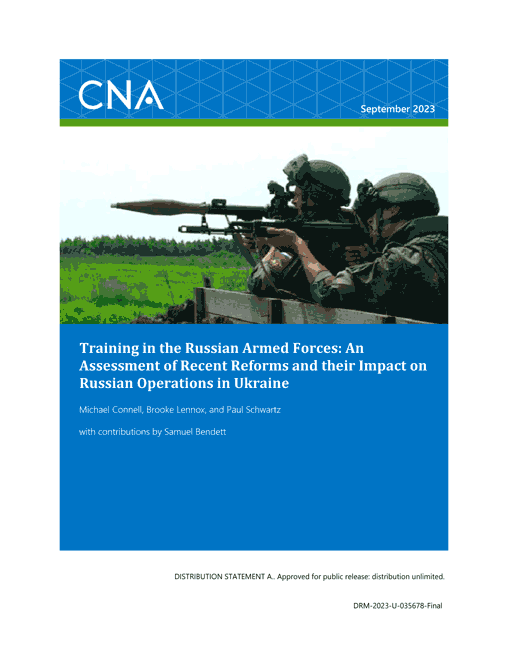Training in the Russian Armed Forces
Since 2009, the Russian military has taken a number of steps to improve the quality of training for its forces and to address various deficiencies that were evident based on the military’s performance in the Russian-Georgian War and subsequent conflicts. The General Staff of the Armed Forces, which is responsible for establishing the standards for operational training, has increased the frequency and tempo of training events (including live-fire exercises), reintroduced the practice of conducting surprise (snap) exercises to assess unit readiness, scheduled more joint exercises between interbranch groupings, and invested in the construction of new training infrastructure, including ranges and training centers such as the much-touted Mulino Complex in the Western Military District. The military has also increased the ratio of better trained contract soldiers to relatively inexperienced conscript soldiers, which has mitigated some of the problems associated with the high turnover rates among enlisted personnel. Perhaps most importantly, Russian troops gained valuable combat experience during operations in the Donbas and Crimea (2014–2015) and in Syria (ongoing).
Although there are signs that these reforms have achieved some of their objectives, for instance by increasing unit readiness levels, Russian leaders have sometimes overstated their success. Training problems have persisted for a variety of reasons, including procedural rigidity, inadequate equipment and ammunition, and lack of standardization because of an emphasis on in-house training within units. Russian tactical training still struggles to emulate real-world combat conditions, with excessively scripted exercises, a lack of dedicated opposing force (OPFOR) in training events, and an emphasis on simulation training as a low-cost substitute for field exercises. Russian forces performed well in Crimea and Syria, but those operations were limited in scope and had clearly defined and achievable objectives. The recent operations in Ukraine were larger in scope and required significant coordination between services across multiple fronts to achieve objectives that, with the benefit of hindsight, were overly ambitious. As such, Russia’s special military operation (SVO) has stressed Russian forces in unprecedented ways, revealing training and other deficiencies that were not evident in the previous operations.
This paper examines how the Russian military trains its armed forces. It begins with an overview of training for conscripts, contract soldiers, and officers, detailing how and where individual and unit training is conducted, and the different mission-essential tasks associated with training. The second part of the paper examines how the Russian military has assessed its training programs, where it has identified problems, and the recent steps taken to address deficiencies. The third section of the paper analyzes Russian operations in Ukraine from the perspective of training. Building on the previous chapters, it examines how specific training initiatives may have impacted Russian operations in Ukraine.
The following is a summary of our key findings:
- There are three primary avenues into the Russian military: as a conscript, a contract soldier, or a military officer. Training for each pathway varies greatly, with conscripts receiving the least training, contract soldiers receiving significantly more training, including both tactical and technical training, and officers receiving the most training (including both higher education and extensive battlefield command and tactical training once they receive their commissions).
- In Russia’s mixed manpower system, officers are primarily responsible for training both conscript and contract soldiers. NCOs (noncommissioned officers) play only a limited role in training enlisted personnel.
- Tactical unit-level training focuses primarily on maintaining and improving combat readiness; however, the quality and scope of training varies greatly between units.
- High turnover rates for both conscripts and contractor personnel require Russian combat units to be substantially rebuilt every few years. The need to constantly train new personnel is not only a drain on available training resources, but also leads commanders to focus more on the training of new recruits and less on training long-term contract soldiers.
- The Russian military continues to place high priority on live-fire exercises. Yet, by their very nature, such exercises tend to be heavily scripted because of safety concerns, and hence less effective. This contrasts sharply with US thinking, which prefers force-on-force exercises with a dedicated OPFOR.
- Poor training appears to have contributed to a number of tactical and operational failures during the ongoing war in Ukraine, including the following:
- During the initial invasion, Russian commanders prioritized speed and deception over force protection and established doctrine, often leaving their formations vulnerable to ambush and attrition by Ukrainian mobile defense units.
- Officers often failed to maintain proper spacing for units on the march, particularly on major transportation arteries, leading to excessively high loss rates from Ukrainian fires.
- Lightly armed reconnaissance units frequently advanced beyond the range of supporting artillery units, where they were more susceptible to being isolated and destroyed by Ukrainian combined arms units.
- Russian units often reacted poorly to ambushes because of insufficient coordination and initiative, leading to an ineffective response.
- Russian methods for coordinating long-range fires appear to be overly centralized, leading to long delays in assigning strike missions and failures to prioritize key targets.
- Russian soldiers often rely on unsecure communications, allowing Ukrainian forces to intercept, jam, and geolocate transmissions and target Russian troops, command and control (C2), and logistics nodes.
- Russian commanders appear to have less latitude for independent action, and they can be slow to respond to emerging threats due to the need to seek higher level approval.
- Russian troops have often exhibited poor discipline (e.g., abandoning their equipment and engaging in looting and indiscriminate violence).
- Russian troops have often appeared either unwilling or unable to maintain their equipment, leading to frequent breakdowns and shortages.
- As more inexperienced reservists and conscripts are mobilized and deployed to Ukraine and as attrition continues to take its toll, the training problems noted above are likely to be exacerbated.
DISTRIBUTION STATEMENT A. Approved for public release: distribution unlimited.
Details
- Pages: 84
- Document Number: DRM-2023-U-035678-Final
- Publication Date: 9/26/2023
